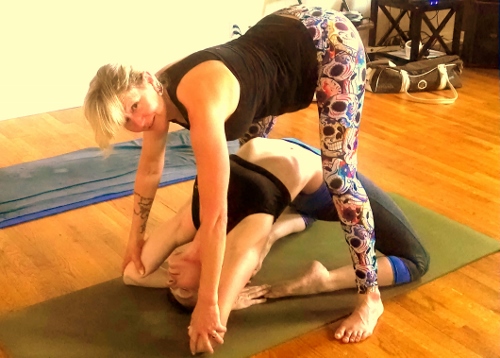I admit it. I am an assist junkie.
I am the student in class trying to mentally will the teacher to walk in my direction and put her hands on me.
I am the one you hear moaning when I am pushed deeper into a stretch or massaged into a place of ease.
I would be perfectly happy being touched through an entire yoga class. However, I’ve also experienced assists that hurt me, took me too deep or just felt wrong.
What makes the difference in the effect of an assist?
I believe the teacher’s experience, training and intuition are largely responsible for the student’s experience.
As a teacher, my training in assists is broad. In addition to being a yoga teacher, I am a massage therapist.
Therefore, I have no reservations about touching my students; I have developed an intuition about the quality of touch that comes with years of practice. Pressure, location and approach are all aspects of assisting that impact the effect on the student, and those are skills that we develop over time.
My 230 hour teacher training was with Stephanie Keach of the Asheville Yoga Center. She is a massage therapist as well, so her assists are taught from that perspective. Her style felt like home to me, and I resonated with her nurturing touch.
From her training, I gained a deep understanding of how to help a student find ease and comfort; to surrender on a physical, mental and even spiritual level. I would feel transformed after her class. Her touch could connect me to the energy of a pose. Her guidance took my body into the space of the asana.
My second teacher training was in therapeutic yoga. Here, the intentions of assists were slightly different. It wasn’t about the “feel good” yummy assist. Instead, our focus was on taking the client into a bio-mechanically sound place to find healing.
The touch of the teacher made me feel grounded and more connected to the earth.
When my body was out of alignment, I would receive a gentle, directional touch that would guide me into a safer expression of the pose.
If I was trying too hard to put my body into a pose, my teacher would assist me so I felt more supported, and I could better find the intention of the pose in a way that fit my body.
It could seem that my teacher trainings on assisting are incompatible. Indeed, they are quite different. Yet it is in that difference that they are complete.
Every student comes to class with a different story.
I may have a student who desperately needs a nurturing touch to comfort him during a time of grief.
There could be a student beside him in trikonasana (triangle pose) who needs to be guided into correct form with an easy glide of my hand.
Across the room, my airy Vada (a person with an air constitution) student needs to feel grounded in her virabadrasana I (warrior one).
In the back of the room, I can read the energy of the student in balasana (child’s pose) and know he doesn’t want to be touched at all.
I am still an assist junkie.
However, now my obsession is in offering appropriate assists to my students. If I can help a student go deeper into his practice and sit into a posture more safely, I am rewarded by the satisfaction I see on his face.
I appreciate all the assists I’ve learned through my trainings, and I continue to melt from the touch of my teachers. When I am assisted in a way that hurts or distracts me from my practice, I learn even more important lessons that help me grow as a teacher.
The next time I am in your class, go ahead, lay your hands on me. You’ll be helping me grow in my journey of assisting.
~
Love elephant and want to go steady?
Sign up for our (curated) daily and weekly newsletters!
Apprentice Editor: Carrie Marzo/Editor: Emily Bartran
Photo: Author’s own











Read 2 comments and reply